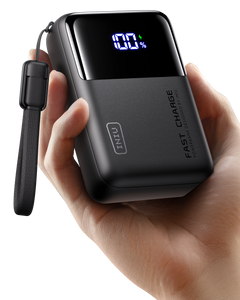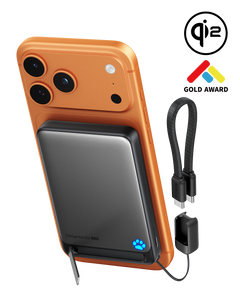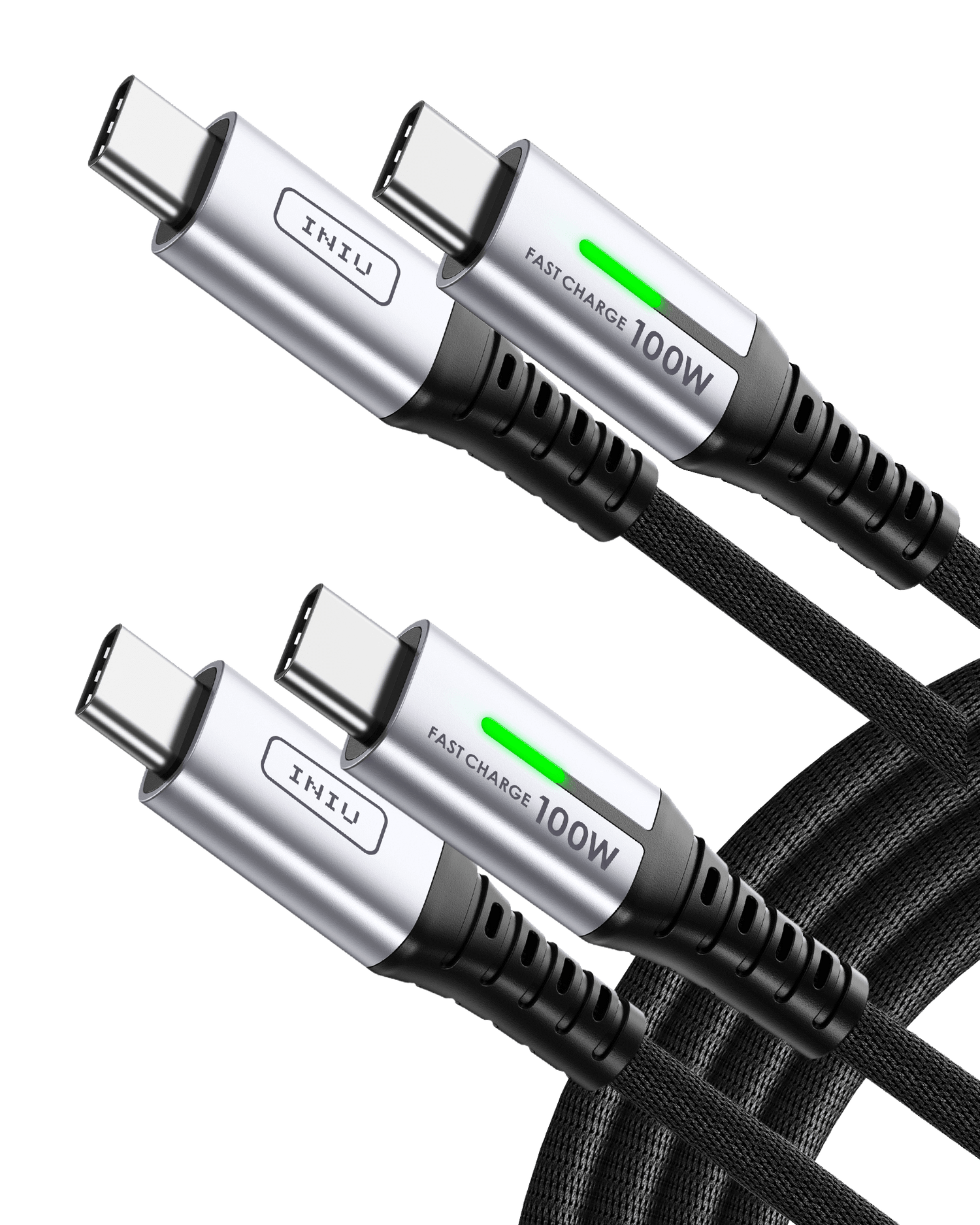
Best Fast-Charging Gear: Top Picks across All Charging Categories
With Black Friday around the corner, this is an ideal time to upgrade your charging game. Whether you're travelling, working from a café, or simply tired of running out of battery at the worst time, choosing the right gear can make all the difference. From fast charging power bank solutions to top-tier cables and wall chargers, the right combination gives you flexibility, speed and peace of mind.
Here we'll walk you through how to pick the right gear and then recommend seven standout models from INIU—covering USB power banks, magnetic portable chargers, wireless chargers, GaN wall units and high-speed USB-C cables. Each one is tied to a specific use-case and clearly shows how you'll benefit in real life.
What to Look for When Choosing Charging Gear

Understanding "Fast" in Fast Charging
When you see a claim like "fast charging power bank", it's not just marketing. Real-world performance depends on three things: (1) output wattage, (2) supported charging protocols (e.g., PD/Power Delivery, QC/Quick Charge, PPS), and (3) compatibility with your device.
For phones and tablets, even 20-30 W output may feel "fast" compared to older 10 W chargers. However, if you want to charge laptop with portable charger, you need 65 W, 100 W or more. If you already use a laptop or power-hungry device, aim for a bank or adapter that clearly states the watt output and PD support.
Also, pd charger refers to wall adapters with high wattage and PD support—they're part of the ecosystem.
Capacity vs Portability
Higher capacity (mAh) is good—but size and weight matter too, especially if you carry the gear in a bag or backpack.
Example: INIU's P62-E1 gives 20,000 mAh and 65 W output in a slim body measuring 4.3″×2.8″×1.1″ (~324 g).
Meanwhile the P63-E1 jumps to 25,000 mAh with 100 W output—but is heavier (~392 g).
So pick based on your real-world behavior: if you often travel light, choose something compact; if you need heavy duty multi-device charging, go for higher wattage/capacity.
Interface & Compatibility
A cable usb c fast charge is just as important as the bank or charger itself. If your cable doesn't support the required wattage or protocol, you won't get the full benefit.
For devices: USB-C input/output is increasingly standard (especially for laptops); USB-A ports still matter for legacy accessories.
Magnetic/wireless: If you use an iPhone with MagSafe/Qi2 or simply prefer cable-free convenience, then a magnetic charger or magnetic portable charger becomes relevant.
Safety & Brand Assurance
Fast charging involves higher currents and heat. Make sure the device you pick has good protection (over-heat, over-current, short-circuit).
INIU emphasizes features like temperature monitoring and offers 3-year warranty. A trusted brand matters.
Also during Black Friday, check that you're buying from official channels or reputable sellers—discounts are great, but authenticity and warranty still count.
Recommended INIU Products In 2025
Now let's dive into specific recommendations, tied to the categories you asked for. For each model, I'll highlight what makes it strong—and how you'll benefit in real life.
USB Power Banks (High-Capacity / Laptop-Capable)
INIU P63‑E1 Power Bank – This is the heavy-duty all-rounder. With 25,000 mAh and up to 100 W output, it's designed to serve laptops, tablets, phones—essentially a full mobile workstation battery.
Core features:
1× USB-A + 2× USB-C ports, meaning you can charge multiple devices simultaneously.
Fits in a bag (4.3″×2.7″×1.4″in) and weighs ~392 g.
Because it supports 100 W, you can legitimately charge laptop with portable charger when away from an outlet.
Use case: You're a content creator, remote worker or student with a laptop + phone + tablet—this bank gives you true power on the go.
INIU P62‑E1 Power Bank – If the P63 is the high-end, this one is the smart compact alternative. With 20,000 mAh and 65 W output, it still supports many lightweight laptops and tablets but is lighter (~324 g) and more travel-friendly.
Core features:
Compact size (4.3″×2.8″×1.1″in) makes it easier to slip into a shoulder bag or laptop sleeve.
High density circuitry (TinyCell + HyperStack) enables the size reduction without losing power.
Use case: You still carry a laptop or tablet, but you value portability more than absolute maximum output. Perfect for business trips or everyday carry.
Magnetic Portable Charger
INIU P73‑E1 Magnetic Wireless Power Bank – This one shifts focus from laptops to convenience and phones. With 10,000 mAh, 45 W wired output + 15 W wireless (Qi2), and magnetic alignment for iPhones 12-17 series, it hits the sweet spot for mobile phone users.
Core features:
Ultra-slim profile (4.2″×2.8″×0.5″in) and lightweight (~189 g) makes it truly pocketable.
Built-in foldable stand lets you prop your phone while it charges.
Magnetic charger capability means easy snap-on with compatible devices—no fussing with cables.
Use case: For phone-centric users who still want backup power, especially on short trips, commutes or when you want quick wireless top-ups.
Wireless Charger (Stand / Home/Office)
INIU I211 Wireless Charger Stand – Turning to your home or desk setup: a Qi2 15 W wireless charging stand that doubles as a neat accessory.
Core features:
Dual-coil design supports both portrait and landscape phone use (e.g., streaming while charging).
Sleep-friendly adaptive LED light means less distraction at night.
Built-in temperature protection (e.g., Temp°Guard) for safety and longevity.
Use case: At your desk or bedside, this becomes your "drop-and-go" charger. It complements your portable gear by taking care of the fixed location.
GaN Charger (Wall Adapter / PD Charger)
INIU A11‑E1 100 W GaN Charger – If you're investing in power banks and cables, don't forget the wall side. This is a premium pd charger option.
Core features:
Up to 100 W output, meaning it can easily charge laptops, tablets and phones.
GaN (gallium nitride) technology keeps the charger compact and efficient—in other words, high-power without high bulk.
Multiple ports mean fewer adapters: you can plug in your laptop + phone + tablet into one unit.
Use case: At home, office or hotel—this charger becomes your main hub. It ensures that when you're plugged in, you're not limited by slow charging.
USB Cable (Critical Accessory)
INIU D5CC 2P 100 W USB‑C to USB‑C Cable – Many users focus on banks and chargers, but forget the cable—which can easily become the bottleneck.
Core features:
Rated for 100 W fast charging and data transfer (480 Mbps).
Durable build (45,000+ bend test) and comes as a 2-pack (6.6 ft each) so you can leave one in your bag and one in your desk.
Compatibility: phones (iPhone/Samsung), tablets, laptops—any USB-C gear.
Use case: You've got a great bank and charger—but if you use an old or weak cable, you won't get full speed. This cable ensures you get what the gear promises.
Picking the Right Combination for Your Needs

Heavy-duty mobile workstation: You carry a laptop, tablet, phone, maybe switch between hotel, café and home. Choose INIU P63-E1 for serious output + INIU A11-E1 for your outlet charger + D5CC-2P cable to tie it together.
Business traveller / mixed-use: You carry a laptop sometimes, mainly phone and tablet. Choose INIU P62-E1 for lighter load + INIU D5CC-2P cable + maybe swap INIU I211 wireless charger for desk use.
Phone-first user: You mostly rely on your smartphone (maybe iPhone with MagSafe or Qi2) and want something just for that. Choose INIU P73-E1 magnetic portable charger + INIU I211 wireless desk charger for overnight.
Fixed desk/home setup supplement: You're mostly at your desk or home. Choose INIU A11-E1 wall charger for main station + INIU D5CC-2P cable for flexibility—and keep a compact bank like INIU P50-E1 as emergency backup.
FAQ
Q: What does "fast charging" really mean for a power bank?
A: It means the bank supports a high watt-output and compatible protocol so your device receives current rapidly. For phones, that might mean going from 0-50% in 30 minutes instead of 60. For laptops, it means you can keep working rather than waiting hours. The key is having matching hardware (bank->cable->device).
Q: Can I safely use a power bank to charge my laptop?
A: Yes—provided the bank supports enough wattage and provides PD or relevant protocol. If the bank only gives 18 W, you won't be able to run a laptop effectively. A unit that supports at lease 65 W or 100 W (and has the right port) gives you real laptop-charging capability.
Q: Do I need a magnetic or wireless charger, or is cable fine?
A: It depends on your habit. If you want "set it and forget it" convenience—wireless or magnetic is great (especially for phones). If you don't mind plugging in/more versatile devices, cable may still be the fastest route. Wireless often runs 10-15 W (phone only), while wired and PD for other devices is often far faster.
Q: If I buy a "fast charging power bank", do I still need a good cable and adapter?
A: Absolutely. The chain is only as strong as its weakest link. A bank might support 100 W, but if your cable is rated for 30 W, you'll never hit 100. So the cable matters—and so does the wall charger if you're plugging in at home.
Q: How do I pick the right capacity or wattage?
A: Look at your devices:
For phones/tablets: 20-30 W is good, capacity maybe 10,000-20,000 mAh.
For laptops or multi-device use: aim for 65-100 W (or higher) output and 20,000 mAh+ capacity.
For travel or carry-light: size and weight matter—get the best power you can for the weight you're willing to carry.
Conclusion

As Black Friday deals start dropping, you're in a strong position to upgrade your entire charging setup—not just buy a single power bank. A smart approach is to think of your system: fast charging power bank + high-speed cable + PD wall charger + a magnetic or wireless option if it fits your device style.
By selecting gear that matches your real-world behavior (travel vs desk vs phone only), you'll make an investment that pays dividends—not just today, but every time you plug in.









